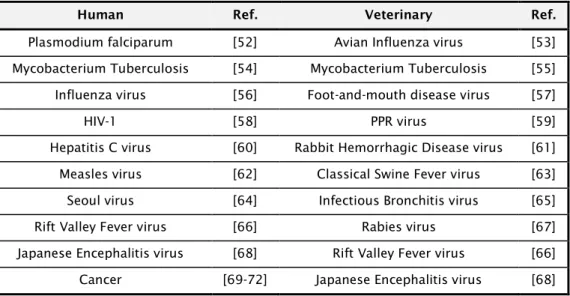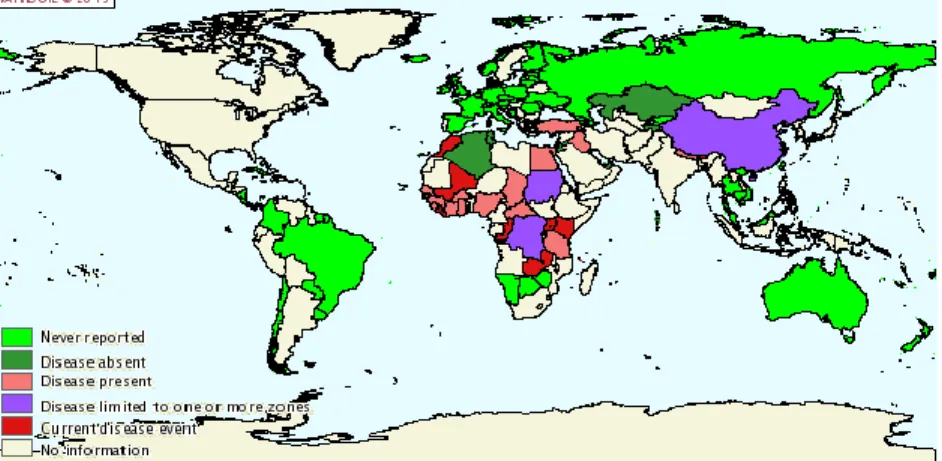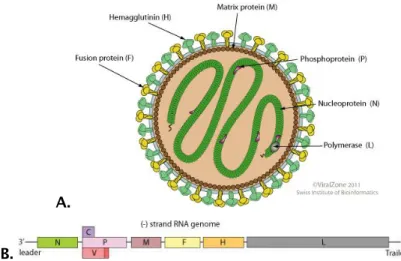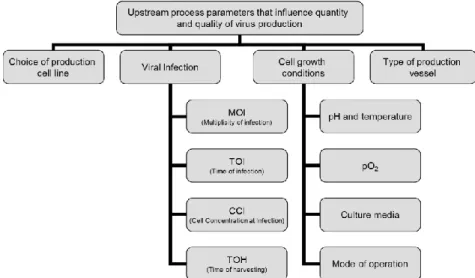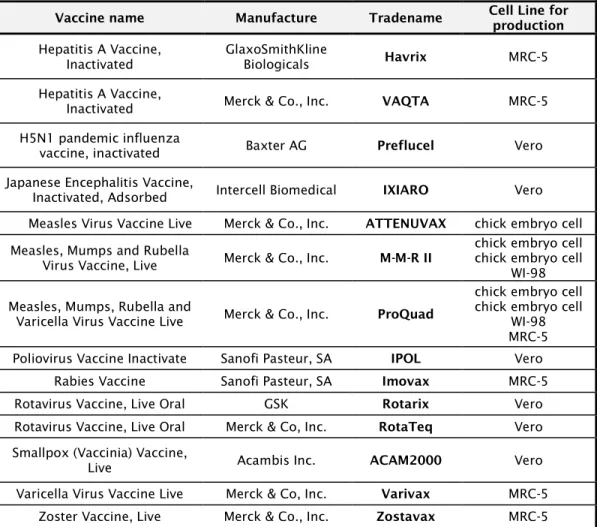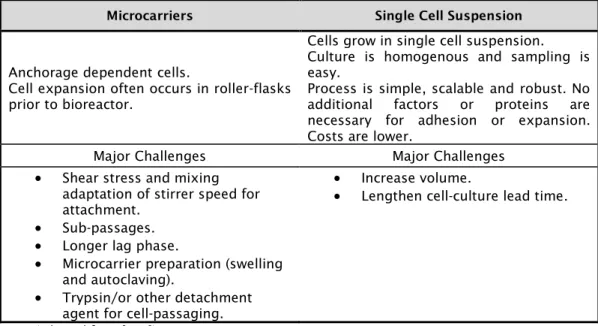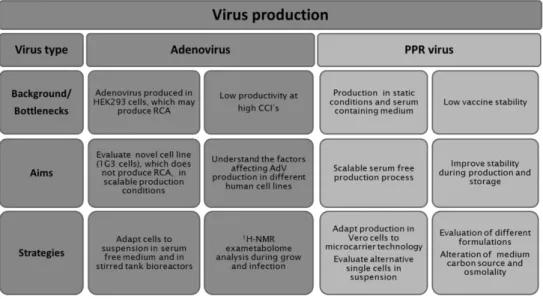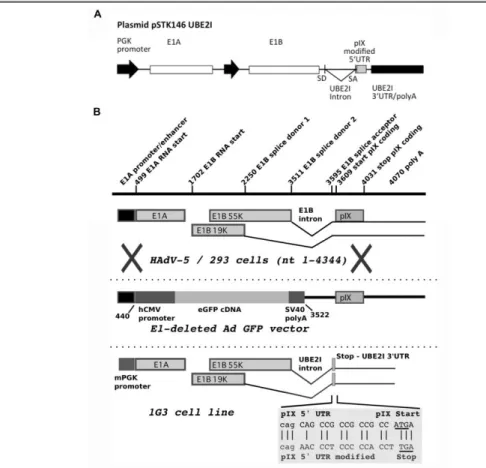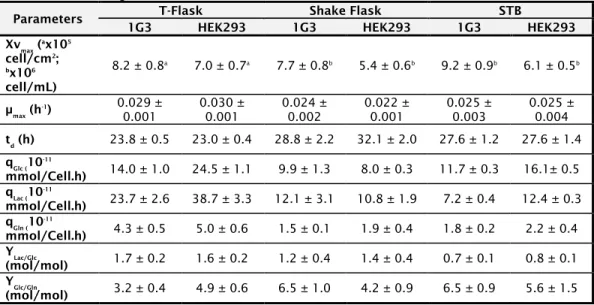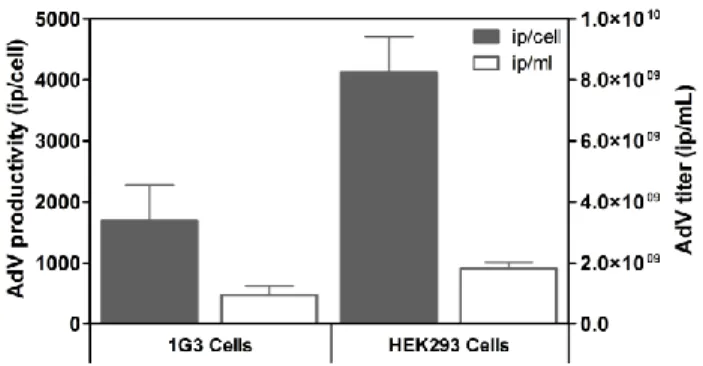Ana Carina Santos Ferreira da Silva
Dissertation presented to obtain the Ph.D degree in Engineering
and Technology Sciences, Biotechnology
Instituto de Tecnologia Química e Biológica António Xavier | Universidade Nova de Lisboa
Strategies for improved Adenovirus and PPR
vaccine production in different cell lines:
from bioprocess development to final formulation
Oeiras,
Ana Carina Santos Ferreira da Silva
Dissertation presented to obtain the Ph.D degree in Engineering
and Technology Sciences, Biotechnology
Instituto de Tecnologia Química e Biológica António Xavier
Universidade Nova de Lisboa
Oeiras, December, 2015
Strategies for improved Adenovirus and PPR
vaccine production in different cell lines:
from bioprocess development to final formulation
Strategies for improved Adenovirus and PPR vaccine
production in different cell lines:
from bioprocess development to final formulation
Ana Carina Santos Ferreira da Silva
Dissertation presented to obtain a Ph.D degree in Engineering
and Technology Sciences, Biotechnology at the Instituto de
Tecnologia Química e Biológica António Xavier, Universidade Nova
de Lisboa
Supervisor:
Paula M. Alves
Co-Supervisor:
Pedro E. Cruz
Instituto de Tecnologia Química e Biológica António Xavier,
Universidade Nova de Lisboa, Oeiras, Portugal
Strategies for improved Adenovirus and PPR vaccine production in
different cell lines: from bioprocess development to final formulation
By Ana Carina Silva
Second edition: January 2016
Cover
Composite image illustrating different steps of viral production processes By Ana Carina Silva
ITQB-UNL/iBET Animal Cell Technology Unit
Instituto de Tecnologia Química e Biológica António Xavier -
Universidade Nova de Lisboa/ Instituto de Biologia Experimental e
Tecnológica
Av. Da República EAN, 2780-157 Oeiras, Portugal
Fax: +351 21 442 11 61; Phone: +351 21 446 91 00
http://tca.itqb.unl.pt
http://www.itqb.unl.pt
http://www.ibet.pt
Copyright © 2016 by Ana Carina Silva All rights reserved
Ana Carina Silva - PhD dissertation
From left to right: Dr Claudio Soares, Dr Miguel Prudêncio, Dr Miguel Fevereiro, Dr Pedro Cruz, Ana Carina Silva, Dr Paula Alves, Dr Francesc Gòdia and Dr Ana Sofia Coroadinha.
Supervisors:
Paula Maria Marques Leal Sanches Alves, PhD, Principal Investigator and
Director of the Animal Cell Technology Unit at ITQB-UNL/iBET, Inv. Associated Professor, FCT-UNL and CEO of IBET, Oeiras, Portugal.
Pedro E. Cruz, PhD, Chief Scientific Officer of ECBio, Oeiras, Portugal and
former Senior Scientist at Animal Cell Technology Unit at ITQB-UNL/iBET, Oeiras, Portugal.
Jury:
Francesc Gòdia, PhD, Full Professor of Chemical Engineering and Vice-Dean at
Universitat Autònoma de Barcelona, Spain, member of the Executive Committee of the European Society for Animal Cell Technology.
Miguel Fevereiro, PhD, Principal Investigator of Virology Laboratory at National
Institute of Agrarian Research (INIAV, I.P.), Oeiras, Portugal, Director of Strategic Research Unit of and Production and Animal Health Services at INIAV, Invited Associate Professor at Évora University, Portugal.
Miguel Prudêncio, PhD, Investigador Principal / Group Leader at Instituto de
Medicina Molecular, Lisboa, Portugal
Ana Sofia Coroadinha, PhD, Head of Cell Line Development & Molecular
Ana Carina Silva - PhD dissertation
Foreword
The present thesis dissertation is the result of several years of research at the Animal Cell Technology Unit of ITQB-UNL/iBET, Oeiras, Portugal, under the supervision of Dr Paula M. Alves and Dr Pedro E. Cruz. It gave me the opportunity to work in the challenging fields of cell culture and viral production for vaccination and gene therapy applications.
This thesis intends to identify and investigate some of the major bottlenecks in the upstream bioprocesses for virus production. Two products were selected based on their importance in the gene therapy field (Adenovirus) and the challenging demand of developing a thermostable vaccine for the eradication of Peste des Petits Ruminant Virus in Africa. These products characteristics and complexity of their production systems were the starting point for the different challenges faced during this work. The main focus of this dissertation was based on the selection of the best cell host for production and the best formulation to maintain virus product quality during storage.
Ana Carina Silva - PhD dissertation
À Filipa
Aos meus Pais
À memória dos meus Avós Álvaro e Maria
Ana Carina Silva - PhD dissertation
“
Learn from yesterday, live for today, hope for
tomorrow. The important thing is not to stop
questioning.”
Ana Carina Silva - PhD dissertation
Acknowledgements
I would like to acknowledge all the people directly or indirectly involved in this thesis, which supported and helped me during this long, but rewarding, journey.
To, Dr Paula Alves, my supervisor, with whom I learned so much. Her outstanding personality, scientific attitude, truly dedication and professionalism have made me grow as a scientist and as a person. For her guidance, encouragement, confidence, patience and friendship. For always pushing me forward to evolve and be confident and for all the great opportunities she has provided to me during all these years.
To Dr Pedro Cruz, my co-supervisor for the support, suggestions and discussions during my thesis.
To Prof. Manuel Carrondo, for his endless support, valuable suggestions and guidance throughout these years. For his enthusiasm, inspiration, and for his sharp view of science and technology.
To Dr Genevieve Libeau and Dr Emanuel Albina, for the fruitful visit to CIRAD-EMVT in Montpellier, where I had my first contact with Peste des Petits Ruminants (PPR) virus work; Olivier Kwaitek and all the friends I had the opportunity to make there, Renata, Lucia, Edwin, Patricia, Manuel, Cecile, Catherine.
To the memory of Dr Tom Barrett and to Dr Rosemary Ngohto, for the great company and support during the MARKVAC meetings in Mali and Ethiopia. To Dr Martha Yami and all the team at NVI in Ethiopia for the opportunity to proceed with the PPR vaccine; in particular to Dr Gelagay Aylet, Dr Woinshet Akalu and Dr Hassen Belay from NVI; and to Dr Karim Toukara, Dr Sanne Charles Bodjo and D. Nick Nwankpa from PANVAC.
To Dr Stefan Kochanek and Claudia Küppers for their input, contribution and opportunity to work with the Human Amniocyte cells. Thank you for their valuable suggestions and discussions.
To Inês and Daniel for being dedicated students and their contribution to this work, for their patience and for helping me learning how to supervise young students.
Ana Carina Silva - PhD dissertation
To Eng. António Cunha for the help with the lyophilization experiments and the useful discussions about technology transfer.
To all present members of the Animal Cell Technology Unit; Ana Paula Terrasso, Catarina Brito, Cláudia Correia, Francisca Monteiro, Hélio, Paulo Fernandes, Ricardo Perdigão, for their promptness to help and for creating a stimulating and great working environment; to former members André Bengala, Tiago Ferreira, Isabel Marcelino, Sonia Sá Santos, Ana Mendes, Ana Lúcia, Nuno Carinhas. To Nita’s memory, who always help me since the first day at the lab...I will never forget you.
I acknowledge the financial support from Fundação para a Ciência e Tecnologia (project PTDC/EBB-BIO/119501/2010, PhD grant SFRH/BD/45786/2008, National NMR Network (REDE/1514RMN/2005), and European Commission (Contract No 018933 NoE CLINIGENE; MARKVAC, FP6-2002-INCO-DEV-1) without which this thesis would not have been possible.
I am deeply grateful to, Ana Sofia, Ana Teixeira, António, Cristina, Filipa, Margarida, Marlene and Marcos, for all the support, loyalty, encouragement, laugh, friendship and for always taking care of me. Thank you for being with me and for being as you are.
Aos meus amigos, em especial à Fátima, à Marina, ao Ricardo, ao Francisco, à Beatriz (a princezinha que marcou para sempre as nossas vidas), à Tato, ao Zé, à Sara, ao Rui, ao Lourenço, à Vera, à Carolina, ao Numa, à Nadia, à Isabel, à Inês, à Fátima C., ao Dada, à Emilia, à Mafalda, à Andreia, à Rita, ao Ricky, ao Ivan, por perceberem as minhas ausências e mesmo assim estarem sempre tão perto e cuidarem de mim, a minha segunda família.
E por fim, aos meus avós, aos meus pais e à minha irmã, a quem dedico esta tese. À memória dos meus avós Maria e Álvaro por tudo o que me ensinaram e por todo o apoio que jamais irei esquecer. Aos meus pais por me apoiarem sempre. Pelo carinho, pelo optimismo, pelo encorajamento. À Filipa a minha manita, por me ouvir, por me apoiar, por estar ao meu lado sempre…
Ana Carina Silva - PhD dissertation
Abstract
Viral products, including viral vaccines and viral vectors, are important tools for disease prevention and therapy. Viral vaccines, such as attenuated or inactivated rabies virus, influenza virus or hepatitis virus vaccines are powerful tools to limit the number of serious viral infections and pandemics. This type of biopharmaceuticals are used to improve human quality of life with vaccination being the most cost-effective method available for preventing economic losses and increasing the lifespan of both people and livestock. On the other hand, adenoviruses, adeno-associated viruses and retroviruses are among the viral vectors currently being developed for delivering genetic material to the target cell in a growing number of gene therapy clinical applications.
The production of viral products is typically based on cell culture, the exception being the use of eggs as a mean of virus replication prior to inactivation as in the case of influenza virus vaccine. Several factors must be considered when selecting an appropriate cell line for a given bioprocess. Productivity, is of course, important but other aspects such as process simplicity and cost, scalability, reproducibility, safety, regulatory history, production platform compatibility, and availability of preferred production media may also play a decisive role. As a result, new and improved platforms are continuously being developed propelled by the need to increase and improve product availability and quality.
Two different viral systems, Adenovirus vectors (AdV) and Peste des Petits Ruminants (PPR) virus, were selected for this thesis due to their contrasting position on the viral products domain. AdV belong to the most widely used tools for the delivery of transgenes into cells in vitro and in vivo with applications ranging from gene therapy and cancer therapy, to the development of prophylactic and therapeutic vaccines. Adenovirus vectors have been extensively used for research both at preclinical and clinical levels (the majority in phase I/II clinical trials) and two products based on adenovirus for the treatment of cancer have been approved in China. Consequently, the market need for adenovirus is increasing, creating a demand for new production methodologies of high quality, high efficacy vectors.
Contrary to AdV, which are non-enveloped viruses, PPR is an enveloped virus which makes it very sensitive to temperature. PPR has become the next
Ana Carina Silva - PhD dissertation
veterinary disease on target for elimination, after the successful eradication of Rinderpest in 2011. Several efforts are being taken to develop DIVA vaccines (which enable differentiation between infected and vaccinated animals) for PPR and to improve the efficacy of the current attenuated vaccine, via the increase of its thermal stability.
Both products share similar challenges but there are also product specific bioprocess bottlenecks that need to be addressed. In this thesis, several cell lines and culture strategies were evaluated in their capacity to produce AdV and PPR vaccine. Several cell culture and virus production parameters were assessed namely multiplicity of infection (MOI), cell concentration at infection (CCI), the use of serum-free media and the scalability of the production process for both systems. Being the thermal stability a very important factor for vaccine use, approaches to improve the current PPR vaccine are also presented together with their application in one of the production laboratories.
In Chapter 1, the state of the art on animal cell culture for virus production is presented. The several bioengineering challenges affecting upstream processing are reviewed. A special focus is also made to the factors affecting virus stability during production and storage.
In Chapter 2, a newly developed human amniocyte-derived cell line (1G3 cells) was evaluated in its ability to produce AdV and in comparison to the human cell line HEK293 typically used for those viral vectors. The impact of MOI, CCI and harvesting time (TOH) on AdV production were evaluated in shake flask and bioreactor. Overall, the AdV infection experiments with 1G3 cells showed that (i) infection was most efficient at a MOI of 5 infectious particles/cell; ii) infection done at a CCI 3x106 cell/mL in bioreactor provided
the higher virus titers; iii) the preferable time of harvest was 48 hours post-infection, corresponding to the higher virus concentration, mainly in the intracellular fraction. This strategy allowed a 3-fold increase in the AdV volumetric productivity obtained in batch culture in comparison to HEK293 cells. The human amniocyte-derived cell line (1G3 cells) showed to be a valid alternative substrate for adenovirus vectors production.
Ana Carina Silva - PhD dissertation
The aim of Chapter 3 was to study the impact of adenovirus infection in two producer cell lines (HEK293 and 1G3 cells) metabolism, and gain further insights into the cell density effect which occurs at higher densities for 1G3 cells. The exometabolome of both cell lines, infected at different concentrations in shake flask and bioreactor cultures, was analyzed by 1H-NMR spectroscopy.
The cultures supernatant was analyzed along time to evaluate how the virus manipulation of the cell metabolism evolves in both cell lines.
In Chapter 4, two scalable processes were evaluated as possible alternatives for the currently used production process of PPR attenuated vaccine that uses monolayers of Vero cells grown in roller bottles or static flasks, i.e. processes with very limited scalability. i) Microcarrier cell culture technology to produce PPR vaccine in Vero cells and ii) single cell suspension cultures of BHK-21A or HEK293 cells, significantly simplifying the existing production process were studied.
Two strategies to improve the stability of the current PPR vaccine are presented in Chapter 5. Firstly, new formulations based on the Tris buffer were tested, with and without the addition of sucrose and trehalose and compared with the formulation normally used to stabilize the vaccine, the Weybridge medium. The results show a virus half-life of 21 hours at 37ºC and 1 month at 4ºC for the Tris/trehalose liquid formulation. In the lyophilized form, the formulation was able to maintain the viral titer above the 1x104 TCID
50/mL (>10
doses/mL) for at least 21 months at 4ºC (0.6 log reduction), 144 hours at 37ºC (0.6 log reduction) and 120 hours at 45ºC (1 log reduction). Secondly, a strategy based on culture medium composition manipulation aiming at improving the intrinsic PPR vaccine stability was also evaluated. The addition of 25 mM fructose resulted in a higher virus production (1 log increase) with higher stability (2.6 fold increase compared to glucose 25 mM) at 37ºC.
Chapter 6 presents the technology transfer operation of a new candidate
formulation to the production platform of PPR vaccine preformed at National Veterinary Institute (NVI) in Ethiopia. The results showed an increased thermal stability of the vaccine, especially at 37 and 45ºC, as expected from results obtained in Chapter 5 which validates the data obtained.
Ana Carina Silva - PhD dissertation
Chapter 7 discusses the implications of the findings and main
achievements of this thesis. The challenges and hurdles associated with viral manufacture using animal cell cultures and their effects during the production process are discussed.
Overall, this thesis describes novel and/or alternative production processes for two of complex biopharmaceuticals (Adenovirus vectors and PPR attenuated vaccine) taking into account the current bottlenecks in their production. It contributes to improve current knowledge in vaccine process development trying to move towards more robust, cost-effective and safe (RCA formation for AdV) manufacturing. Furthermore, the results obtained for these two biopharmaceuticals can provide useful hits for production of other similar products or even be used as a starting point for development of new production platforms.
Finally, it is important to highlight that the results obtained in Chapter 5 were used to transfer the developed formulation to the production of the PPR vaccine in Ethiopia (Chapter 6), with the results showing an improvement in the stability of the vaccine produced thus demonstrating a successful technology transfer operation.
Ana Carina Silva - PhD dissertation
Resumo
Os vectores virais e vacinas virais têm vindo a ganhar uma importância clínica cada vez mais relevante. Os vectores virais como o adenovírus, os vírus adeno-associados ou os retrovírus, são ferramentas que têm vindo a ser desenvolvidas para entregar material genético à célula alvo em terapia génica. As vacinas virais, como as vacinas da raiva (atenuada ou inativada), da gripe ou da hepatite, são ferramentas poderosas para limitar o número de infeções virais graves e pandemias. Estes tipos de produtos biofarmacêuticos são utilizados para melhorar a qualidade de vida dos seres humanos sendo a vacinação o método disponível mais rentável para a prevenção de perdas económicas e aumento do tempo de vida do homem, mas também dos animais.
Muitos fatores têm que ser considerados na escolha da linha celular apropriada para qualquer bioprocesso. A produtividade é, naturalmente, uma consideração importante, mas outras questões incluem a facilidade e economia da sua utilização, a escalabilidade, a reprodutibilidade, a segurança, historial regulamentar, a compatibilidade com a plataforma de produção e a disponibilidade dos meios de produção pretendidos. Assim, são continuamente desenvolvidas novas e melhores plataformas para expandir e melhorar a disponibilidade e qualidade do produto.
Dois sistemas virais, vectores adenovirais (AdV) e a vacina da Peste des Petits Ruminants (PPR), foram selecionados para esta tese devido à sua posição contrastante no domínio dos produtos virais. Os AdV pertencem às ferramentas mais usadas na entrega de transgenes em células in vitro e in vivo com aplicações desde a terapia génica e a terapia contra o cancro, até ao desenvolvimento de vacinas profiláticas e terapêuticas. Este vectores têm sido extensivamente usados na investigação tanto nos níveis pré-clínico e clínico (na sua maioria em fase I/II) e dois produtos baseados em adenovírus para o tratamento de cancro foram recentemente aprovados na China. Por isso, as necessidades de mercado para os vectores adenovirais estão a aumentar, criando a necessidade de metodologias de produção de vectores concentrados com a garantia de qualidade e eficácia.
Ao contrário dos AdV, que são vírus sem envelope e com ciclo celular lítico, o virus PPR têm envelope que os torna mais sensíveis à temperatura. A PPR tornou-se a próxima doença veterinária alvo para a completa eliminação, após a
Ana Carina Silva - PhD dissertation
erradicação da Rinderpest, conseguida em 2011. Vários esforços têm sido efetuados para o desenvolvimento de vacinas marcadoras de doença (capazes de diferenciar entre animais vacinados de animais infetados) e para melhorar a eficácia da vacina atenuada atual, passando pelo aumento da sua estabilidade térmica.
Nesta tese, são apresentadas linhas celulares alternativas e estratégias de cultura para a produção de dois produtos virais relevantes, os vectores adenovirais e o vírus da PPR atenuado. Vários parâmetros de cultura celular e produção viral são alvo de estudo nomeadamente a multiplicidade de infeção (MOI), a concentração na altura da infeção (CCI), a utilização de meios sem soro e a escalabilidade do processo para ambos os sistemas. Sendo a estabilidade térmica um factor muito importante na utilização de vacinas, alternativas para melhorar a atual vacina da PPR são também descritas juntamente com a sua aplicação num dos laboratórios de produção.
No Capítulo 1, faz-se uma revisão do estado da arte em cultura de células de animais para a produção de vírus. Os vários desafios de bioengenharia que afetam o processo de produção são apresentadas. Um foco especial é feito também sobre os factores que afetam a estabilidade dos vírus durante a produção e o armazenamento.
No Capítulo 2, é avaliada a aplicabilidade de uma linha celular humana derivada de amniócitos recentemente desenvolvida (células 1G3), em comparação com a linha celular normalmente utilizada, na produção de AdV, as células humanas HEK293. Os efeitos da MOI, da CCI e o tempo de recolha (TOH) na produção de AdV foram analisados em frascos agitados e em biorreator. Em geral, as experiências de infeção com as células 1G3 mostraram que (i) a infeção por AdV foi mais eficiente a uma MOI de 5 partículas infecciosas/célula, ii) a infecção feita a uma CCI 3 em biorreator, originou os títulos virais mais elevados, iii) o tempo de recolha preferível foi de 48 horas pós infecção, correspondente à concentração mais elevada de vírus, principalmente na fração intracelular. Esta estratégia permitiu um aumento de 3 vezes na produtividade volumétrica de AdV obtidos na cultura em batch, em comparação com células HEK293. A linha celular derivada de amniócitos humanos (células 1G3) mostrou ser uma alternativa válida para a produção de vectores adenovirais.
Ana Carina Silva - PhD dissertation
O principal objectivo do Capítulo 3 foi estudar o impacto na infeção por adenovírus no metabolismo de duas linhas de células de produção (as células HEK293 e as 1G3), e tentar obter conhecimentos sobre o efeito da concentração celular que ocorre a valores superiores nas células 1G3. O metaboloma extracelular exometabolome de ambas as linhas celulares, infetadas a diferentes concentrações em frasco agitados e em biorreatores, foi analisado por espetroscopia de 1H-RMN. Os sobrenadantes das culturas foram analisadas
ao longo do tempo para avaliar o modo como a manipulação pelo vírus faz evoluir o metabolismo em ambas as linhas celulares.
No Capítulo 4, dois processos escalonáveis foram avaliados como possíveis substitutos para a produção da vacina atualmente utilizada contra a Peste des Petits Ruminants (PPR) usando monocamadas de células Vero cultivadas em frascos estáticos ou frascos de rolantes. Na primeira aplicou-se a tecnologia de cultura de células em microsuportes para a produção da vacina PPR usando células Vero e na segunda foram usadas como alternativa culturas células em suspensão, as células BHK-21A ou HEK293, o que pode simplificar significativamente o processo de produção atualmente existente.
Duas estratégias para melhorar a estabilidade da vacina atual PPR são apresentadas no Capítulo 5. Em primeiro lugar, novas formulações baseadas no tampão Tris foram testadas com e sem a adição de sacarose e trealose e comparadas com a formulação normalmente utilizada para estabilizar a vacina, o meio Weybridge. Os resultados mostram um tempo de semi-vida do vírus de 21 horas a 37 ºC e 1 mês a 4 ºC para a formulação de Tris/trealose líquida. Sob a forma liofilizada, a formulação foi capaz de manter o título viral acima de 1x104 TCID
50/ml (> 10 doses/mL) durante pelo menos 21 meses a 4 º C (0,6 log
perdidos), 144 horas a 37 ºC (0,6 log perdidos) e 120 horas a 45 ºC (1 log perdidos). Em segundo lugar, foi também avaliada uma estratégia baseada na manipulação da composição do meio de cultura com o objetivo de melhorar a estabilidade intrínseca da vacina PPR. A adição de 25 mM de frutose resultou na produção de vírus mais elevada (aumento de 1 log) e com uma estabilidade superior (2,6 vezes de aumento, em comparação com glucose 25 mM) a 37 ºC.
Ana Carina Silva - PhD dissertation
O Capítulo 6 apresenta os resultados da operação de transferência de uma nova formulação candidata na plataforma de produção da vacina contra a PPR realizados no Instituto Nacional de Veterinária (NVI), da Etiópia. Os resultados mostraram um aumento da estabilidade térmica da vacina, especialmente a 37 a 45 ºC, tal como o esperado a partir dos resultados obtidos no Capítulo 5 validando assim os dados obtidos.
O Capítulo 7 discute os resultados apresentados nos outros capítulos e resume as principais implicações identificando as principais metas atingidas nesta tese. A identificação dos novos desafios e obstáculos associados ao fabrico viral utilizando culturas de células animais são discutidos.
Em resumo, esta tese descreve novos processos de produção alternativos para dois biofármacos complexos tendo em consideração os desafios atuais de produção e propondo novas estratégias para superá-los. Contribui-se para melhorar o conhecimento atual do desenvolvimento de processos permitindo avançar para métodos de produção mais robustos, eficazes, económicos e seguros (sem formação de virus recombinantes no caso dos Adenovirus). Os resultados obtidos para os dois produtos podem ser úteis para a produção de outros produtos semelhantes, ou até um ponto de partida para o desenvolvimento de novas plataformas de produção.
Finalmente, é de notar que os resultados descobertos no Capítulo 5 foram utilizados para transferir a formulação desenvolvida para a produção da vacina PPR na Etiópia (Capítulo 6) onde os resultados obtidos mostraram uma melhoria da estabilidade da vacina produzida demonstrando assim o sucesso desta operação de transferência de tecnologia.
Ana Carina Silva - PhD dissertation
Thesis publications
Original articles
1. Silva, A.C., Teixeira, A. and Alves, P.M, “Impact of Adenovirus infection in host cells metabolism evaluated by 1H-NMR spectroscopy“ (submitted).
2. Silva, A.C.*, Simão, D*, Küppers, C.*, Lukas, T. *, Sousa, M.F.Q., Cruz, P.E, Kochanek, S., Carrondo, M.J.T. and Alves, P.M., “., “Human amniocyte-derived cells are a promising cell host for adenoviral vector production under serum free conditions” Biotechnology Journal 2015, 10(5): 760-71 (*These authors contributed equally).
3. Silva, A.C., Yami, M., Libeau, G., Carrondo, M.J.T. and Alves, P.M, “Testing a new formulation for Peste des Petits Ruminants vaccine in Ethiopia”, Vaccine 2014, 32 (24), 2878–2881.
4. Silva, A.C., Carrondo, M.J.T. and Alves, P.M., “Strategies for improved stability of Peste des Petits Ruminants Vaccine”, Vaccine 2011, 29, 4983– 4991.
5. Silva, A.C., Delgado, I., Sousa, M.F.Q., Carrondo, M.J.T. and Alves, P.M., “Scalable culture systems using different cell lines for the Production of Peste des Petits Ruminants Vaccine”, Vaccine 2008, 26 (26), 3305-3311.
Review articles
- Silva, A.C.*, Peixoto, C. *, Lukas, T. *, Küppers, C. *, Cruz, P.E., Alves, P.M and Kochanek, S., “Adenovirus vector production and purification”, Current Gene Therapy 2010, 10 (6), 437-455. (*These authors contributed equally)
Book Chapters
- Silva, A.C., Roldão, A., Teixeira, A., Fernandes, P., Sousa, M.F.Q., Alves, P.M. 2015. “Cell immobilization for the production of viral vaccines” In: Al-Rubeai, Mohamed (Ed.), Animal Cell Culture, Cell Engineering, Vol. 9, Springer.
- Silva, A.C., Fernandes, P., Sousa, M.F.Q., and Alves, P.M., “Scalable production of adenovirus vectors” (2014) In: Adenovirus – Methods and Protocols, Chillón, Miguel; Bosch, Assumpció (Eds.), Series: Methods in Molecular Biology, Volume 1089, 3rd Edition, Springer.
- Silva, A.C., Simão, D., Sousa, M.F.Q., Peixoto, C., Cruz, P.E., Carrondo, M.J.T., and Alves, P.M., “Production and purification of Ad vectors: current status and future needs for Adenovirus vector production” (2012), The CliniBook: Clinical gene transfer, Edited by Odile Cohen-Hauguenauer –EDK, Paris, pp.
Ana Carina Silva - PhD dissertation
Other publications to which the author has contributed during this thesis
- Fernandes P., Silva A.C., Coroadinha A.S., Alves P.M., “Upstream Bioprocess for Adenovirus Vectors, In Adenoviral Vectors for Gene Therapy, Elsevier 2016 (in press).
- Duarte T., Carinhas N., Silva A.C., Alves P.M., Teixeira A.P.”1H-NMR protocol for exometabolome analysis of cultured mammalian cells” (2014) In: Pörtner, Ralf (Ed.), Animal Cell Biotechnology: Methods and Protocols, vol. 1104, 3rd Edition, Springer.
- Roldão, A., Silva, A.C., Mellado, M.C.M., Alves P.M., and Carrondo, M.J.T. (2011) The Biophysical Basis | Viruses and Virus-Like Particles in Biotechnology: Fundamentals and Applications. In: Murray Moo-Young (ed.), Comprehensive Biotechnology, Second Edition, volume 1, pp. 625– 649. Elsevier
- Matias, A.A., Serra, A.T. Silva, A.C., Perdigão R., Ferreira, T.B., Marcelino I., Alves, P.M. and Duarte, C.M.M., “Portuguese winemaking residues as a potential source of natural anti-adenoviral agents”, Int J Food Sci Nutr 2010, 61 (4), 357-368.
- Ferreira, T.B., Perdigão R., Silva, A.C., Zhang, C., Aunins, J.G., Carrondo, M.J.T. and Alves, P.M., “293 cell cycle synchronisation in adenovirus vector production”, Biotechnol Prog 2009, 25 (1), 235-243.
Ana Carina Silva - PhD dissertation
Table of contents
Chapter 1 — Introduction ……….…..……….... 1
Chapter 2 — Human Amniocyte-derived Cells for the Production of Adenovirus
Vectors ………...………...………..………... 65
Chapter 3 — Metabolic Alterations Induced by Adenovirus Infection ……...…. 93
Chapter 4 — Scalable culture systems using different cell lines for the Production of Peste des Petits Ruminants Vaccine ….…………..………..……… 113
Chapter 5 — Stabilization of biotherapeutics - from cell culture to final
formulation ……….……….……… 135
Chapter 6 — Technology Transfer to Ethiopia: a vaccine formulation research
and development study ………...…….……….……….. 161
Ana Carina Silva - PhD dissertation
Abbreviations
Abbreviation Full form
AdV Adenovirus
ACF Animal Component Free
BHK Baby Hamster Kidney
BUGS Buffered gelatine-sorbitol CCI Cell Concentration at Infection
CHO Chinese Hamster Ovary
CPE CytoPatic Effect
DMEM Dulbecco’s Modified Eagle’s Medium
DO Dissolved Oxygen
EDTA Ethylenediaminetetraacetic acid
FBS Fetal Bovine Serum
Glc Glucose
Gln Glutamine
GMEM Glasgow Minimum Essential Medium
HEK Human Embryonic Kidney
hpi hours post infection
IP Infectious Particles
Lac Lactate
LM Lactalbumin hydrolysate-Manitol
LS Lactalbumin hydrolysate-Sucrose
MEM Minimum Essential Medium
MOI Multiplicity Of Infection
PBS Phosphate-Buffered Saline
PPR Peste des Petits Ruminants
PPRV Peste des Petits Ruminants Virus
RCA Replication Competent Adenovirus
RP Rinderpest
SLAM Signalling lymphocytic activation molecule
Suc Sucrose
TCID50 Tissue Culture infectious Dose at 50%
TD Trehalose Dihydrate
TOH Time Of Harvest
Tre Trehalose
VP Virus Particles
Chapter
1
Introduction
Part of this chapter was based on the following manuscripts:
Adenovirus vector production and purification, Silva, A.C., Peixoto, C.,
Lukas, T., Küppers, C., Cruz, P.E., Alves, P.M and Kochanek, S., (2010) Current Gene Therapy, 10 (6), 437-455.
Viruses and Virus-Like Particles in Biotechnology: Fundamentals and Applications, Roldão, A., Silva, A.C., Mellado, M.C.M., Alves P.M., and
Carrondo, M.J.T. (2011) The Biophysical Basis | In: Murray Moo-Young (ed.), Comprehensive Biotechnology, Second Edition, volume 1, pp. 625–649. Elsevier
Table of contents
1. Introduction _____________________________________________________ 4
1.1. Milestones of Cell Culture and viral applications _______________________ 42. Viral products ___________________________________________________ 7
2.1. Types of viruses ______________________________________________________ 7 2.1.1. Virus with DNA ______________________________________________________ 7 2.1.2. Virus with RNA ______________________________________________________ 9 2.2. Gene therapy _______________________________________________________ 11 2.3. Vaccine development ________________________________________________ 15 2.3.1. Veterinary versus Human Vaccines __________________________________ 18
3. Adenovirus _____________________________________________________ 19
3.1. Adenovirus Biology __________________________________________________ 19 3.2. Adenovirus vectors __________________________________________________ 21
4. Peste des petits ruminants _____________________________________ 23
4.1. Peste des Petits Ruminants Virus Biology _____________________________ 23 4.2. Peste des Petits Ruminats Vaccines __________________________________ 25
5. Virus production process _______________________________________ 29
5.1. Production __________________________________________________________ 30 5.1.1. Cell lines for Viral Vaccine production________________________________ 31 5.1.2. Cell lines for Adenovirus production _________________________________ 33 5.1.3. Cell growth conditions and viral infection ____________________________ 35 5.2. Purification _________________________________________________________ 45 5.3. Formulation and storage ____________________________________________ 47
6. Scope of the thesis _____________________________________________ 49
7. Acknowledgments ______________________________________________ 50
8. Author contribution ____________________________________________ 50
9. References _____________________________________________________ 50
1. Introduction
Manufacturing of biopharmaceuticals involves the use of cell culture systems as a unique method of product development. These types of products are difficult to obtain by conventional pharmaceutical development processes. Cell culture is used in a wide range of applications such as development of model systems for research, analysis of cellular structures and their mechanisms, drug discovery and evaluation, stem cell research and production, genetic engineering and production of biologics such as antibodies, vaccines, viral vectors for gene therapy and proteins. The increase demand of animal cell bioprocess for biological products created great scientific and economical interest in research and development for this area. Each cell line shows its specificities, and its use for viral production has advantages but also disadvantages compared to the other cell lines. Based on a thorough understanding of the pros and cons of individual host cells for process performance, properties of other cell lines, specific aspects of virus–host cell interaction and process options can be better evaluated. Overall, a systematic comparison of cell lines might help to develop process optimization strategies, as well as to assess quality differences concerning the virus strains and antigens produced.
1.1. Milestones of Cell Culture and viral applications
The need for cell culture, especially at large scales, became apparent with the need for viral vaccines. The major epidemics of polio in the 1940s and 1950s promoted a lot of effort to develop an effective vaccine. When it was finally demonstrated in 1949 that poliovirus could be grown in cultures of human cells, considerable interest was shown to develop large quantities of the polio vaccine using cell culture. The polio vaccine, produced from inactivated virus, became one of the first commercial products of cultured animal cells. After that it was realized that passage in cell culture was also a mean of attenuation, presumably by fortuitous selection of mutants better adapted to replication in vitro than in living hosts. Cell culture also permitted conscious selection of mutants by isolation of single clones and by incubation at temperatures below the normal temperature of the host. Thus, the period
between 1950 and 1980 saw the development of numerous attenuated viral vaccines, including those for polio (Sabin oral), measles, rubella, mumps and varicella.
In 1961 Howard Temin discovered that specific genetic mutations could be inherited as a result of virus infection [1]. Based on his experimental observations he concluded that chicken cells infected with the Rous sarcoma virus (RSV) stably inherited viral specific gene mutations that contained the information for the generation of RSV progenies. It became apparent that viruses possessed properties that could be very useful in delivering genes into cells of interest and that genetic engineering may become a new approach for treating genetic diseases. In 1966, Edward Tatum published a paper evoking the effectiveness of viruses to be used in somatic-cell genetics and possibly in genetic therapy [2].
The first officially approved clinical protocol to introduce a foreign gene into humans was approved by the Recombinant DNA Advisory Committee (RAC) in December 1988. In that, no actual therapy was proposed, but instead, S.A. Rosenberg aimed at using gene marking techniques to track the movements of tumour-infiltrating blood cells in cancer patients [3].
Currently, more than 1800 approved gene therapy clinical trials worldwide have been conducted or are still ongoing. Up to date, cancer is by far the most common disease treated by gene therapy. It composes over 60% of all ongoing clinical gene therapy trials worldwide [4, 5]. Three gene therapy products for cancer have recently received market approved, two in China and one in Europe, increasing the confidence in further research and commercialization. Vaccine development has led to eradication of smallpox and the elimination of poliomyelitis and measles from large parts of the world, saving millions of lives. The use of vaccines has also contributed to promote animal health by preventing disease outbreaks that can have a devastating effect on animal production and contributed to the eradication of Rinderpest in 2011. Meanwhile several other types of vaccines have been obtained and are in commercial manufacture or are under development, being most of them viral based. In Table 1.1 are highlighted some of the milestones during the history of cell culture, vaccine development and gene therapy.
Table 1.1: Some important events in the historical of cell culture and vaccine development and gene therapy products.
Year Vaccine Event
1796
Edward Jenner had first speculated that protection from smallpox disease could be obtained through inoculation with a related virus, vaccinia or cowpox. He tested his theory by inoculating eight-year-old James Phipps with cowpox pustule liquid recovered from the hand of a milkmaid, Sarah Nelmes.
1879 Louis Pasteur created the first live attenuated bacterial vaccine (chicken cholera). 1884 The first live attenuated viral vaccine (rabies) was developed by Louis Pasteur, using desiccated brain tissue inactivated with formaldehyde. 1885 Louis Pasteur first used rabies vaccine in humans.
1896 Cholera and typhoid vaccines were first developed.
1897 Plague vaccine was introduced, following the preparation of anti-plague horse serum at the Pasteur Institute by Alexandre Yersin. 1918 Whole-cell inactivated bacterial vaccine (pertussis whooping cough).
1923 Toxoid vaccine prepared from inactivated bacterial toxins (diphtheria).
1930 Cell culture was developed and shown to be able to grow virus, thus paving the way for the subsequent production of viral vaccines. 1931 Freeze-dried vaccine approved by FDA (smallpox).
1949 Viral vaccine produced in vitro with non-neural human cells by Enders (polio). 1951 The first human cell line, HeLa was established.
1954 Freeze drying process for smallpox vaccine greatly improved by Collier to allow global distribution. 1955 The first polio vaccine was licensed - an inactivated poliovirus vaccine (IPV) produced in vitro with primary monkey kidney cells pioneered by Dr. Jonas Salk. 1962 Vero cells were originally isolated from the kidney of a normal (i.e., non-diseased) adult African green monkey by Y. Yasumura and Y. Kawakita at the Chiba University
in Chiba, Japan.
1962 Attenuated Measles Vaccine Developed (Rubeovax) was developed by Maurice Hilleman and colleagues. 1962 Human diploid cell line (WI-38) established by Hayflick.
1977 Last case of smallpox outside of the laboratory.
1980 Rabies human diploid-cell vaccine (Imovax Rabies by Mérieux and Wyvac by Wyeth) were licensed.
1980 The World Health Assembly certified the world free of naturally-occurring smallpox. 1981 The first hepatitis B viral vaccines (plasma-based), developed by Merck and also by the Pasteur Institute, were licensed.
1986 Recombinant virus-like particle hepatitis B vaccine (Recombivax HB by Merck) was licensed.
1987 Protein-conjugated Haemophilus influenzae type b vaccine (PRP-D, ProHibit by Connaught) was licensed. 1988 First officially approved clinical protocol to introduce a foreign gene into humans was approved. 1998 The first vaccine for the prevention of HIV/AIDS (Aidsvax) entered Phase III trial, the first large-scale human trial of an HIV vaccine.
2003 First gene therapy product approved in China, GendicineTM.
2007 FDA approves first U.S. vaccine for humans against the avian influenza virus H5N1.
2009 FDA approved new vaccine (Cervarix, GlaxoSmithKline) for the prevention of cervical cancer.
2011 The World Organisation for Animal Health declares the Eradication of Rinderpest, the second disease in history to be fully wiped out. 2012 FDA approved first seasonal influenza vaccine manufactured using cell culture technology (Flucelvax, Novartis). 2012 First gene therapy product approved in Europe, Glybera.
2. Viral products
Viruses are amongst the simplest biological systems. They behave as intracellular parasites and contain a limited set of genes that encode information for their replication, encapsidation and cell-to-cell propagation. Viruses have been under considerable investigation as a model to study the basic concepts of biology and virology and due to their impact in animal and human health. The main areas of application of viruses include vaccine development and gene therapy [6].
2.1. Types of viruses
The nature of the viral genome has many implications on the life cycle of the virus. Viral genome consists of one or more fragments of single-stranded (ss) or double-stranded (ds) RNA or DNA. Most DNA and positive (+) ssRNA viruses rely on host cell machinery for initiating the replication and transcription of viral genome, not requiring de novo synthesis of other virus gene products. Others, such as dsRNA or negative (-) ssRNA viruses have to deliver into the cell their own polymerase for the synthesis of viral proteins essential for initiating viral replication as host cells do not possess the machinery to cope with dsRNA or negative (-) ssRNA. In addition, many dsRNA viruses deliver their genome within a protein capsid to avoid contact between the dsRNA and the cell cytosol [6].
2.1.1. Virus with DNA
A DNA virus has DNA as its genetic material and replicates using a DNA-dependent DNA polymerase. The nucleic acid is usually dsDNA; ssDNA is less common as during replication ssDNA typically expands to dsDNA. This class of viruses belong to group I or group II of the Baltimore classification system for viruses [7]. Group I virus includes the Adenoviridae, Herpesviridae (herpes simplex virus - HSV) and Baculoviridae (Autographa californica multicapsid nucleopolyhedrovirus) families while group II virus includes the Parvoviridae and Circoviridae families (Table 1.2). Although group VII viruses such as hepatitis B (hepatitis B virus - HBV) contain a DNA genome, they are not considered DNA viruses according to the Baltimore classification, but rather
reverse transcribing viruses because they replicate through an RNA intermediate [6].
Table 1.2: List of virus with DNA genomes.
Virus Family (common names) Virus Examples (naked/enveloped) Virion symmetry Capsid Nucleic acid
type Group Adenoviridae Adenovirus, Canine adenovírus type 2, Human adenovirus type 2 and 5 Naked Icosahedral ds I Baculoviridae Autographa californica multicapsid nucleopolyhedrovirus Enveloped Helical ds I
Circoviridae transmitted virus Transfusion Naked Icosahedral circular ss II
Hepadnaviridae Hepatitis B virus Enveloped Icosahedral ds-RT VII
Herpesviridae Herpes simplex virus, Varicella-zoster virus, Cytomegalovirus, Epstein-Barr virus, Varicella virus Enveloped Icosahedral ds I Papillomaviridae Human papillomavirus, Bovine papillomavirus
Naked Icosahedral circular ds I
Parvoviridae Parvovirus B19, Porcine parvovirus, Adeno-associated virus Naked Icosahedral ss II Polyomaviridae Polyomavirus; JC polyomavirus, Simian virus 40, Goose hemorrhagic polyomavirus, Murine polyomavirus
Naked Icosahedral circular ds I
Poxviridae Smallpox virus, Vaccinia virus Complex coats Complex ds I ds: double stranded; ss: single stranded; RT: reverse transcriptase. (Source: [6])
2.1.2. Virus with RNA
Conversely, an RNA virus has RNA as its genetic material. This nucleic acid is usually ssRNA but may be dsRNA. The International Committee on Taxonomy of Viruses classifies RNA viruses as those that belong to group III, group IV or group V of the Baltimore classification system for viruses [8] and does not consider viruses with DNA intermediates as RNA viruses. These viruses are included in group VI and possess ssRNA genomes that replicate using reverse transcriptase. Viruses such as the human immunodeficiency virus (HIV), simian immunodeficiency virus (SIV) and rous sarcoma (RS) virus (members of the Retroviridae family) are included in this group [6].
2.1.2.1. Group III: dsRNA viruses
DsRNA viruses represent a large group of pathogens whose genome can be monopartite or segmented up to 12 fragments. These viruses do not release the free dsRNA genome in infected cells and require that transcription and synthesis of new dsRNA genomes take place in confined environments. Reovirus and Rotavirus, members of the Reoviridae family are included in this group (Table 1.3).
2.1.2.2. Group IV: (+) ss RNA viruses
Contrasting with the dsRNA or the (−) ssRNA viruses, the genomes of (+) ssRNA viruses are infectious. Icosahedral (+) ssRNA viruses represent a large fraction of all viruses known and include important human pathogens; poliovirus, human rhinoviruses, hepatitis A virus, Norwalk group of viruses, astroviruses, and members of the alpha- and flaviviruses which carry an RNA-containing nucleocapsid are some examples. Unlike (−) ssRNA viruses, the nucleoproteins responsible for protecting the genome from unspecific cellular RNA binding are not expressed in (+) ssRNA viruses. Thus, the synthesis of progeny viruses requires that the capsid proteins of these viruses specifically package the viral RNA genome while excluding the ubiquitous cellular RNA. Group IV includes the Flaviviridae (hepatitis C virus - HCV), Coronaviridae (severe acute respiratory syndrome virus – SARS virus), Picornaviridae and Caliciviridae families (Table 1.3).
Table 1.3: List of virus with RNA genomes.
Virus Family Virus Examples (common
names) Virion Capsid symmetry Nucleic acid type Group
Arenaviridae choriomeningitis Lymphocytic
virus Enveloped Complex (-) ss V
Astroviridae Astrovirus Naked Icosahedral (+) ss IV
Birnaviridae Infectious bursal disease virus Naked Icosahedral ds III
Bornaviridae Borna disease virus Enveloped Helical (-) ss V
Bunyaviridae Rift valley fever Hantaan virus,
virus Enveloped Helical (-) ss V
Caliciviridae Hepatitis E virus, Norwalk virus,
Norovirus Naked Icosahedral (+) ss IV
Coronaviridae Severe acute respiratory
syndrome virus Enveloped Helical (+) ss IV
Filoviridae Marburg virus Ebola virus, Enveloped Helical (-) ss V
Flaviviridae Hepatitis C virus, Dengue virus,
Yellow fever virus Enveloped Icosahedral (+) ss IV
Orthomyxoviridae Influenza A, B and C virus, Enveloped Helical (-) ss V
Paramyxoviridae
Measles virus, Newcastle disease
virus, Rinderpest virus, Peste des Petits
Ruminant Enveloped Helical (-) ss V Picornaviridae Rhinovirus, Hepatovirus, Poliovirus, Hepatitis A virus Naked Icosahedral (+) ss IV
Reoviridae Rotavirus, Reovirus, Bluetongue virus
Naked Icosahedral ds III
Retroviridae HIV , SIV, Lentivirus, Moloney murine leukemia virus Enveloped - ss-RT VI
Rhabdoviridae Rabies virus Enveloped Helical (-) ss V
Tetraviridae capensis virus Nudaurelia Naked Icosahedral (+) ss IV
Togaviridae Rubella virus, Alphavirus Enveloped Icosahedral (+) ss IV ds: double-stranded; (-) ss: negative single-stranded; (+) ss: positive single-stranded; RT: reverse transcriptase. (Source: [6])
2.1.2.3. Group V: (-) ss RNA viruses
Negative ssRNA viruses are classified into seven families: Rhabdo-, Paramyxo-, Filo-, Borna-, Arena-, Bunya- (Hantaan virus and rift valley fever virus - RVFV) and Orthomyxoviridae (Influenza). The first four families are characterized by non-segmented genomes. The remaining three have genomes comprising two, three and six to eight (-) sense RNA segments, respectively. The large group of (-) sense RNA viruses includes: i) highly prevalent human pathogens such as respiratory syncytial virus (RSV), parainfluenza and Influenza viruses; ii) two of the most deadly human pathogens, Ebola and Marburg viruses; iii) viruses with a major economic impact on the poultry and cattle industries, namely the Newcastle disease virus (NDV), rinderpest virus and Peste des Petits Ruminant virus (Table 1.3) [6].
2.2. Gene therapy
Gene therapy involves the use of nucleic acids (DNA or RNA) for the treatment, cure or prevention of human disorders. Depending on the type of disease, this can be achieved either by delivery of a functional, therapeutic gene as a substitute for the defective or missing endogenous counterpart or by reducing the levels of a harmful defective gene product, using various sophisticated tools including naked oligonucleotides, viral and non-viral vectors.
In the late 1970s and early 80s, the emergence of techniques for subcloning mammalian genes into prokaryotic plasmids and bacteriophages were correctly foreseen as precursors of techniques for human gene therapy. Parallel investigations on the biology of avian and murine onco-retroviruses led to the development of retroviral vectors, which began to be used in the mid-80s as a tool for gene transfer into mammalian cells. The first human trial of gene transfer was carried out in the late 80s for the treatment of patients with advanced metastatic cancer. The process consisted in introducing the gene coding for resistance to neomycin into human tumor-infiltrating lymphocytes by retroviral-mediated gene transduction, before their infusion into patients; thus, using the new gene as a marker for the infused cells [3]. Since then, there has been a remarkable expansion in the number of vector systems available to
express human genes directly associated with disease states for therapeutic purposes (Table 1.4).
Table 1.4: Vectors used for Gene therapy
Virus Family/Vector Advantages Limitations
Adenoviridae/
Adenovirus
- High efficiency
- Transduces quiescent and dividing cells
- >30 kb transgene capacity - Easy to produce in high titers
- Coxsackie adenovirus receptor-dependent transduction - Immunogenic
- Existing humoral response to certain serotypes
Retroviridae/
Murine leukaemia virus
- Broad tropism - Low immunogenicity - Stable integration
- Insertional mutagenesis - Unable to transduce quiescent
cells - Inactivation by serum Retroviridae/ Lentivirus - Low immunogenicity - Stable integration to quiescent cells - Insertional mutagenesis - Potential risk of recombination of pathogenic vector (HIV) Parvoviridae/ Adeno-associated virus
- Transduces quiescent and dividing cells
- Very long expression time - Non-pathogenic, low
immunogenicity - Broad tropism
- Very small transgene capacity - Insertional mutagenesis may
be problem
Alphaviridae/
Semliki forest
- High titer - Broad host range
- Efficient transgene expression
- Low transgene capacity - Highly cytotoxic - Short term expression
Alphaherpesviridae/
Herpes simplex-1
- Broad host range, - High titer, - Large capacity
- Latent wild type-viral activation risk, - Antigenic Baculoviridae/ Autographa californica multicapsid nucleopolyhedrovirus - High titer
- Large transgene capacity - Easy production
- Non-pathogenic
- Limited transduction - Production in insect cells - Unstable genome
Non-viral vectors - Easy preparation,
- non-pathogenic
- Limited transduction - Bacterial contaminants
Gene therapy trials using retroviral vectors to treat X-linked severe combined immunodeficiency (X-SCID) constitute one of the most successful applications of gene therapy to date. X-SCID is a disease in which the patient has neither cell - mediated immune response nor is able to generate antibodies. A high rate of immune system reconstitution was observed in patients treated in the X-SCID gene therapy trials [9]; but, 5 out of more than 20 patients developed a leukemia-like illness, of which 4 fully recovered after conventional anti-leukemia treatment [10, 11].
Despite these results, gene therapy trials to treat X-SCID due to deficiency of the adenosine deaminase enzyme continue with relative success in the USA, France, UK, Italy and Japan. In the last decade, the process of retroviral vector production has been under considerable investigation as it presents many difficulties, mainly due to vector instability and low cell productivities hampering the attainment of high viral titers. Strategies based on the manipulation of sugar carbon sources [12, 13], lipids [14], temperature [15] or osmotic pressure [13] used in bioreaction and on the establishment of pioneering packaging cell lines such as 293 FLEX [16] and Flp293A [17] show potential to increase the yields of infectious retroviral vectors. This will allow the generation of high quality clinical preparations for gene therapy applications.
Adenovirus (AdV) vectors are also efficient vehicles for delivering nucleic acids into mammalian cells (see more information of this vectors in section 3.2 below). The human adenovirus type 2 and 5 are the most used vector backbones for adenovirus-mediated gene transfer. However, due to a number of significant disadvantages such as the need to immunosuppress or tolerize patients to a potentially debilitating virus [18, 19], vectors from different serotypes or derived from non-human adenovirus (bovine, sheep and birds) were developed [20, 21]. Recently, canine adenovirus serotype 2 (CAV-2), produced in dog kidney cells, have been gaining increasing attention due to their emerging potential for the study of the pathophysiology and potential treatment of neurodegenerative diseases like Parkinson’s, Alzheimer and Huntington, amongst others. The first clinical trial using recombinant adenovirus was carried out in 1993 with cystic fibrosis (CF) patients [22]. Two years later, the first recombinant adeno-associated virus trial was initiated in CF patients [23]; trials in hemophilia B patients commenced shortly after [24]. Inevitably, lentivirus and recombinant herpesvirus vectors have also entered in clinical trials [25-27]. All four viral vector systems mentioned above are highly efficient systems for gene transfer and expression in vivo in non-dividing cells. In fact, more than 50% of all viral vectors currently undergoing clinical trials are adenovirus (22.2%), retrovirus (18.4%), adeno-associated virus (6%), Lentivirus (5%) or herpes simplex virus (3.2%) (Figure 1.1).
cells, baculoviral vectors have emerged as gene therapy vehicles for the treatment of a wide range of human diseases. Recently, a genetically modified recombinant baculovirus encoding for a cherry-red fluorescent protein under the control of a strong mammalian cell promoter (cytomegalovirus promoter) proved to be effective in transducing a human liver carcinoma cell line, HepG2 [28].
Figure 1.1: Vectors used in Gene Therapy Clinical Trials.
(Source: Journal of Gene Medicine Clinical Trial Database http://www.abedia.com/wiley/index.html)
Other studies indicate that baculoviruses show promising gene expression efficiencies in liver [29], skeletal muscle [30], brain [31] and eye [32]. Importantly, baculoviral vectors present similar efficiencies to adenoviral vectors in transducing human smooth muscle cells, human cardiomyocytes and fibroblasts [33]. The major challenge is the production of high recombinant baculovirus titers [34]. Although metabolic engineering approaches have shown to improve baculovirus titers at high cell densities [34, 35], platforms for the production of baculoviral vectors to be used in gene therapy clinical trials have not yet been implemented.
The first gene therapy products entered the market through China: GendicineTM (SiBiono GeneTech) in 2003 and OncorineTM (Shangai Sunway
Biotech) in 2006 for cancer treatment. GendicineTM is a replication defective
AdV5 vector expressing p53 from a Rous sarcoma virus (RSV) promoter, and is approved for use in head and neck squamous cell. OncorineTM is an oncolytic
virus product derived from AdV5 vector for nasopharyengeal carcinoma combined with chemotherapy. Noteworthy in this case is the fact that the
China's State Food and Drug Administration (SFDA) approved Gendicine without data from a standard phase III clinical trial [36]. Consequently, soon after the approval of Gendicine™, there was discussion about the efficacy of the treatment [37]. In 2004, Ark Therapeutics Group plc received the first commercial GMP Certification in the EU for the manufacture of commercial supplies of gene-based medicines (Cerepro®). Cerepro® is an adenoviral vector harboring the gene for the Herpes simplex virus thymidine kinase (HSV-tk), developed by Ark Therapeutics Group plc and intended for the treatment of malignant brain tumors. In 2008, Cerepro® became the first and so far the only adenoviral vector that has completed a phase III clinical trial [38].
Finally in 2012, Glybera® (uniQure biopharma, Netherlands) received market approval for the treatment of lipoprotein lipase deficiency (LPLD) using an adeno-associated vector, being the first gene therapy product approved in the Western World. Hopefully, these achievements will facilitate further research and commercialization of valuable gene therapy products.
2.3. Vaccine development
The development process for vaccines is unique. Vaccine development is highly capital intensive and risky. Given the importance of safety with biologics, the vaccine industry is highly regulated. Vaccine development is normally carried out in an iterative fashion. Less than one in ten vaccine candidates actually achieves the market. The high attrition rate is due to the unpredictability of the biological microorganisms needed to produce vaccines, and to the uncertainty of how immune system will process and react to the vaccine antigen. Some vaccine candidates may produce appropriate levels of immune response, but induce important adverse reactions. Other vaccine candidates may be safe, but ineffective at preventing diseases. With the current tendency to combine several antigens into a single vaccine, the challenges associated with developing safe and effective vaccines are even greater. Research to discover new vaccine antigens and novel approaches to immunization usually takes several years, and costs tens of millions of dollars. Once a discovery is made, several developments must be undertaken to reach the licensing stage.
Vaccines based on live viruses have been traditionally effective and relatively easy to produce. The elimination of smallpox was accomplished through mass vaccination with the live vaccinia virus, a mildly pathogenic animal virus related to smallpox. Likewise, live attenuated vaccines are well tolerated and highly immunogenic. The live attenuated poliovirus vaccine developed by Dr. Albert Sabin in 1961 eradicated poliovirus disease in the Western hemisphere and drastically reduced their incidence rate worldwide. Vaccines against infectious diseases such as the yellow fever, typhoid fever, mumps and shigella are also based on lived attenuated viruses. The attenuation of viruses is accomplished through one of the following methods: 1) attenuation of the pathogen by physical means; 2) selection of naturally occurring mutants that lead to infection with abortive replication of the pathogen while retaining its immunogenicity. Inactivated (killed) vaccines can also stimulate a protective immune response. The inactivated poliovirus vaccines (IPOL, Sanofi Pasteur SA), Influenza vaccines (Fluarix, GlaxoSmithKline) and typhoid fever vaccines (Typhim Vi, Sanofi Pasteur MSD) constitute some examples. The disease causing organism is inactivated with chemicals such as formaldehyde; the main drawback of these vaccines is that they require boosting for continuous, efficient immune response. Nowadays, using molecular biology and DNA manipulation methods, it is possible to express protective proteins in adequate live vectors with the purpose of designing live vaccines against various types of pathogens. In addition, the development of reverse genetics systems for the recovery of viruses from cDNA has made it possible to rapidly generate recombinant attenuated derivatives.
Advances in molecular biology allowed also the development of platforms for the production of virus-like particles (VLPs) as vaccines against emergent diseases. Virus-like particles are composed by viral structural proteins that, when expressed in recombinant systems, form multi-protein structures mimicking the organization and conformation of authentic native viruses but lacking the viral genome. Table 1.5 lists some examples of current licensed vaccines and presents the different types of vaccines and corresponding advantages and disadvantages.
Vaccine Type Licensed Vaccines Advantages Disadvantages Live attenuated vaccines virus Smallpox, polio, measles, mumps, rubella, chicken pox, rotavirus, shingles, influenza, yellow fever - Produce a strong immune response - Often give lifelong immunity with one or two doses
- Remote possibility of reversion to wild type - Must be refrigerated to stay potent
bacterium Tuberculosis, typhoid
Inactivated vaccines virus Inactivated polio, Japanese encephalitis, hepatitis A, Influenza (seasonal and pandemic), rabies
- Safer and more stable than live
vaccines - Do not require refrigeration: more easily stored and transported - Produce a weaker immune response than live vaccines - Usually require additional doses, or booster shots
bacterium Whole cell pertussis
Toxoid vaccines Purified protein toxoid Tetanus, anthrax and diphtheria - Teaches the immune system
to fight off the bacterial toxins - Necessary an adjuvant to increase immunogenicit y - Several doses Subunit vaccines Purified virus-like particles (VLPs) Hepatitis B and human papillomavirus - Target to very specific parts of the microbe - Fewer antigens, so lower chance of adverse reactions - When developing a new vaccine, identifying the best antigens can be difficult and time consuming Purified
protein Acellular pertussis
Purified
polysaccharide Pneumococcal for adults, typhoid
Conjugated vaccines Polysaccharide conjugated to carrier protein Pneumococcal for infants, haemophilus type B, bacterial meningitis - Allow infant immune system to recognize certain bacteria
- Can only be used for bacteria (?)
DNA vaccines In development /clinical testing
- Produce a strong antibody and cellular immune response - Relatively easy and inexpensive to produce - Still in experimental stages
Recombinant vector vaccines In development /clinical testing
- Closely mimic a natural infection, stimulating a strong immune response - Still in experimental stages (Adapted from: [39]; [40]; [41])
